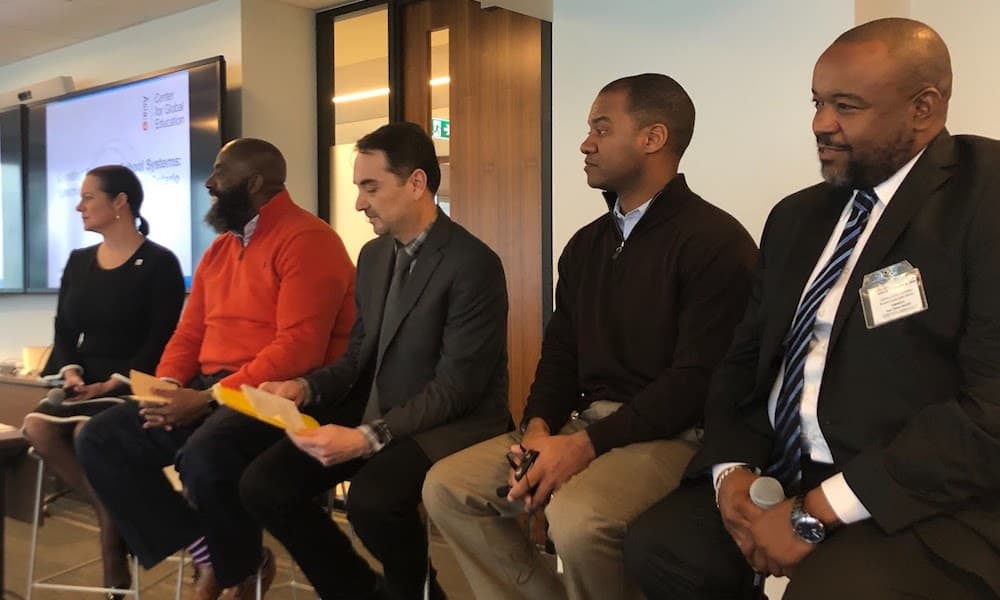Getting Clearer: Dismantling Systemic Oppression in Public Education

By: Anthony Jackson, Ph.D
Sitting on the floor in a circle with his students, a fourth-grade teacher at the Chief Dan George Public School in Toronto, Canada, calls on a student recently immigrating with his family from India. “Sometimes people say that my family isn’t as good as they are because our skin is darker. It makes me feel bad.” The teacher asks the class, “What do we call that?” “Shade-ism!” is the shouted response. “What’s that an example of?” “Prejudice!” “How can we help him with this problem?” “He should tell those people that it’s not nice and they are wrong and to leave him alone.”
This was just one example of extraordinary conversations about race witnessed by school district leaders from across the US participating in a two-day study tour focused on equity practices in Toronto schools. The Toronto District School Board (TDSB) is a member of Asia Society’s Global Cities Education Network, a consortium of leadership teams from high-performing school systems in the Asia-Pacific region and North America that have met since 2012 to learn from and with each other about best practices that drive excellence and equity for all students.
The meeting in Toronto was designed to expand learning from the Global Cities Education Network districts to other school systems – in this instance 10 districts from the League of Innovative Schools organized by Digital Promise. Asia Society joined with Digital Promise to design the study tour and several webinars that preceded it. Members of the National Public Education Support Fund representing major US philanthropies also attended the event. The convening was supported by a generous grant from the Hewlett Foundation.
Comfort in Discomfort
The comfortable conversation about an often uncomfortable topic like racism among fourth-graders at Chief Dan George Public School and across Toronto schools is the intentional result of an enormous cultural shift to deal head-on with the systemic barriers to achievement and healthy development affecting the districts’ significant non-white population. TDSB is the most diverse school system in Canada. It prides itself on being part of Ontario, one of the highest performing provinces in Canada, contributing substantially to the nation’s top-ten ranking in the world for average math, reading and science scores on the 2018 OECD Programme for International Student Assessment (PISA). Yet TDSB has not been successful for all its students, especially those of color.
TDSB’s overall high performance was driven by a sustained effort started nearly 20 years ago by the Ontario Ministry of Education to improve results throughout the province. While equity was a goal from the start, it took on greater urgency with the release of a 2017 report from the Enhancing Equity Task Force, a group independent of TDSB reviewing the district’s progress. The Task Force engaged a wide group of stakeholders including parents, students, and community members as well as educators who called attention to troubling gaps in performance by race and ethnicity, which the district’s data reinforced. The Task Force found that the barriers to access and engagement in high-quality learning for these students were not isolated instances but were endemic throughout the system.
Putting Truth on the Table
In response, the leadership of TDSB, led by Director of Education John Malloy, redesigned school improvement processes in fundamental ways. First, as Malloy said at the meeting, “we
put our truths on the table” by acknowledging that the rhetoric of equity in some ways masked the reality of practice. “We’ve been using the word equity for decades. People don’t disagree
because who could? But is the data telling a story that keeps people up at night? As leaders, are we uncomfortable enough to do something different? … We need to identify and name the
accountabilities. Our Equity work can become complacent, we need the language of anti-oppression to motivate action….Our learning culture hasn’t changed centuries of oppression.”
Colleen Russell-Rawlins, Associate Director, Equity, Well-Being, and School Improvement, echoed Malloy’s perspective. “We have to name racism when we see it. We used to talk about bias, discrimination – coding (racism) in a lot of other languages. Now we’re more specific in saying, for example, anti-black or anti-Asian racism.” Willing to name the problem as sustained, systemic oppression, the TDSB leadership relied heavily on the extensive data collected on students to uncover how that oppression occurs.
For example, while celebrating its 86% on-time graduation rate, the focus shifted to the 14% that were underperforming. Who were they in kindergarten? Who wasn’t reading by grade 1? Who was placed in special education by grade 3? Who was being suspended by grade 6? Who was not invited to the academic, college-bound track by grade 9? The data showed clearly that children of color, especially black students, were over-represented among those not achieving key milestones in their learning journey. And yet, who was being held accountable?
Malloy said, “We had to start asking ourselves hard questions. The first question is, who are we not serving? Who are we oppressing and what needs to change in me and us to make a difference? Who am I protecting? Whenever I am making decisions … am I protecting those who possess significant privilege and not our students who need us the most? What does my bias say to how I see a situation? How do we facilitate a conversation (among leaders) to think about what’s happening in me, in the classroom, in the system that is a barrier to students?”
Using data to illuminate systemic inequities, naming racism and other forms of oppression and summoning the courage to confront the roots of the problems in beliefs and attitudes has led to important “interruptions” in practices within TDSB. For example, the validity of the special education system was questioned by asking is there a racialized component? Are only some students, especially racialized students, being identified with special needs? As a result, many special education classes are being eliminated — ending a practice which, had effectively shut out disproportionately high numbers of black students from engaging in the mainstream curriculum.
The TDSB leadership would not have been able to make bold moves without the backing of its Board of Trustees. Robin Pilkey, Chair of the TDSB Board, noted that the Trustees truly represent the diversity of TDSB itself, which brings different perspectives to their work, including that of communities of color whose children have historically been underserved by
Improvement Implementation Pushback
Toronto schools. Nevertheless, Pilkey said the Trustees needed to have their own difficult conversations about race and listen intently to their constituents to bring forth a multi-year plan that specifically targeted equity in outcomes for all students. The trailblazing work in TDSB has not gone without its detractors. Segments of the community have voiced outrage at the direction TDSB and its Board of Trustees have taken. One of the city’s newspapers negatively portrayed Director of Education Malloy as a “social justice warrior” — a term he accepts with some pride! Malloy noted that after the initial burst of enthusiastic support for the district’s equity agenda, supporters have become less vocal during the implementation phase. “We need to start going back out into the community every six months with data on our progress, good or bad, to re-engage our stakeholders.”
TDSB’s policies ultimately find expression at the school level. Mirroring the system-wide use of data to illuminate inequities, school principals are guided in using their own school’s data to ask tough questions about differences in performance by race and ethnicity and to plan sustainable changes to achieve more equitable results. Annually, each school as part of its improvement plan must identify three goals; an achievement goal, a well-being goal, and an equity goal. However, according to Associate Director Russell-Rawlins, “Where schools are making the greatest progress, those three goals are blended. Equity is embedded in the way practice and improvement happens.”
Creating equitable cultures in Toronto schools leads to the kinds of conversations witnessed among fourth-graders at Chief Dan George Public School. In all the schools that were visited, there was a distinct emphasis, as one participant put it, “on the restoration and protection of the dignity of students of color.’ He added, “racism and oppressive systems strip you of your dignity… (TDSB) has a systematic way of restoring it.”
Participants also witnessed the integration of principles of equity in classroom learning. One noted “we saw intentionality around building the capacity of school staff to understand the roots of racism…to be comfortable having those conversations, and then creating units to have those conversations with students.” Another added, “Educators engaged students about privilege and identity. A focus on identity positively permeated the school.”
Students in TDSB schools – both students of color and white students – experience a culture of excellence and inclusion that is rare if not unprecedented among public schools. Malloy and his colleagues would be the first to say that it’s still a work in progress and the success or failure of their innovations will be borne out in the data. For now, it’s an experiment in courageous justice that’s well worth watching.
For more, see:
- Getting Clearer: Equity in Schools
- Getting Clearer: Culturally Responsive Pedagogy
- Getting Clearer: HQPBL as an Equity Imperative
Stay in-the-know with innovations in learning by signing up for the weekly Smart Update.
Anthony Jackson, Ph.D. is Vice President for Education and Director, Center for Global Education at Asia Society.
This blog is part of an ongoing Getting Smart series called Getting Clearer. The nature of this series and our blog is to have a diverse set of voices and ideas to help us and our audience get clearer. Are there topics that you’re interested in #GettingClearer about? Email [email protected] with “Getting Clearer” in the subject line.





0 Comments
Leave a Comment
Your email address will not be published. All fields are required.